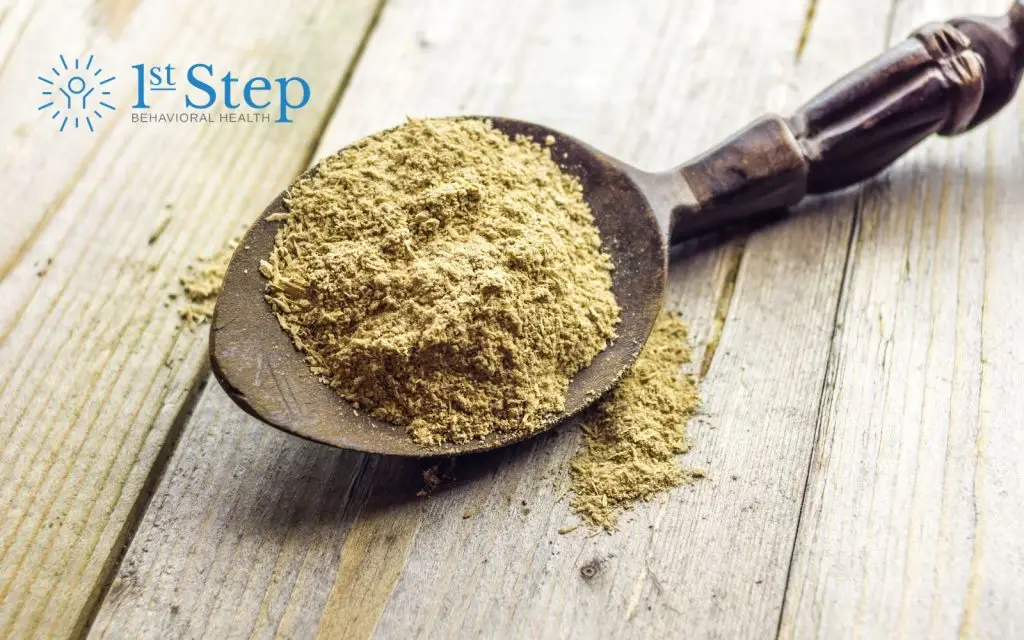If you or someone you love is struggling with addiction, it’s understandable to look for alternatives that may help ease anxiety, stress, or chronic pain without resorting to harmful substances. When looking for an alternative to addictive drugs, two plant-based supplements—kava and kratom—are often mentioned.
Kava and kratom are both marketed for their relaxing effects, mood-lifting properties, or even mild pain relief. Both kava and kratom are sold in powder, pill, or liquid extract forms in wellness stores, grocery stores, and online. Despite their similar uses, they come from entirely different plant families and carry unique risks for users.
In this article, you’ll learn:
- What are the differences between kava and kratom?
- What are the effects of kava and kratom on physical and mental health?
- What are the safety concerns associated with kava and kratom?
What is Kava?
Kava is derived from the Piper methysticum plant, which is native to the Pacific Islands. Traditionally, native Southeast Asian countries and Polynesian cultures used ground kava root powder mixed with coconut milk to create drinks for ceremonies, stress relief, and promoting relaxation.
How Does Kava Work?
Kava contains compounds called kavalactones, which interact with the brain to produce sedative effects, reduce anxiety, and encourage mental clarity. It’s often used today in natural health circles for treating anxiety, stress, and insomnia.
Kava comes in many forms, including:
- Ground root mixed with liquid (traditional method)
- Pills or capsules
- Liquid extracts
Kava is often consumed recreationally to promote relaxation; however, it’s also marketed medicinally for mood and sleep support.
What is Kratom?
Kratom comes from the leaves of the Mitragyna speciosa tree, a plant related to coffee, and is native to Southeast Asia. In native Southeast Asian countries, locals often chew the leaves or brew them into teas for energy and pain relief.
How Does Kratom Work?
Kratom’s two primary active compounds called mitragynine and 7-hydroxymitragynine, interact with opioid receptors in the brain. In small doses, kratom produces stimulant effects, while high doses of kratom produce sedative and painkiller effects, similar to those produced by opioid painkillers. Because of this, some people use kratom to come off opioid drugs.
Kratom comes in a variety of forms, including:
- Powder (often stepped into tea or packed into capsules)
- Liquid extract
- Pill form
Popular strains like Maeng Da and Bali are commonly used in the U.S. The Maeng Da strain acts as both a stimulant and a painkiller.
Kava vs Kratom: Key Differences
Though kava and kratom may appear similar—both are plant-based supplements consumed for mood-enhancing and relaxing effects—they have important differences.
Kava comes from the Pacific Islands, while kratom is native to Southeast Asia. Additionally, the kava plant is in the pepper family, while kratom belongs to the coffee family.
People usually use kava for relaxation and stress relief. On the other hand, kratom might be used for pain relief, a boost of energy, or to overcome opioid addiction. While kava is mainly a sedative, kratom is a stimulant at low doses and a sedative in high doses.
Kava tends to be less addictive than kratom, which comes with a high risk of dependency. That said, it is still possible to become addicted to kava.
Safety Concerns and Health Risks
Kava
While kava is generally seen as safer than kratom, frequent use or high doses may lead to liver damage, especially when consumed with alcohol or certain medications. There are dangers of kava root use, particularly when combined with other substances. The Food and Drug Administration has issued warnings, although many products remain on shelves.
Kratom
The concerns around kratom are more serious. According to the National Institute on Drug Abuse, kratom addiction is real, and U.S. consumers purchase kratom for self-treatment of pain or withdrawal symptoms without medical guidance.
Warnings against kratom use include:[1,2,3]
- The Drug Enforcement Agency has considered scheduling kratom as a controlled substance.
- The Centers for Disease Control and Prevention (CDC) links kratom to multiple deaths, especially when mixed with other drugs.
- The National Center for Complementary and Integrative Health warns of unique risks, including dependency, seizures, and liver toxicity.
Why Are People Turning to Kava and Kratom?
For individuals recovering from addiction or trying to avoid opioid painkillers, the appeal of kava and kratom is understandable. Both substances promise natural relief from anxiety, pain, and emotional distress, symptoms common among individuals in recovery from addiction.
Addiction treatment facilities have seen a rise in patients using kava and kratom in attempts to self-manage withdrawal or mental health symptoms. While they might offer short-term relief, using these substances without medical supervision can undermine recovery and potentially replace one addiction with another.
What Does the Research Suggest?
While there is research suggesting kava may be helpful in short-term treatment of anxiety, the benefits, effects, and dangers of both kava and kratom remain understudied and poorly regulated.
Research on kava has found:[4]
- Some small studies show positive effects on anxiety and stress.
- Long-term safety remains unclear.
- The risk of liver damage is serious, especially with improper use.
Research on kratom has revealed:[5]
- Some users report relief from opioid withdrawal
- Many develop tolerance, dependence, and kratom withdrawal symptoms.
- There’s no standardized dosing, making it risky.
A comprehensive review by the Alcohol and Drug Foundation concluded that kratom’s native Southeast Asian use doesn’t translate safely to Western markets, where different ways to produce, concentrate, and market the drug lead to greater harm potential.
Should You Use Kava or Kratom?
If you feel you could benefit from treatment for pain, anxiety, or addiction recovery, consult a medical professional, not a supplement aisle. Using kava or kratom instead of proven therapies and medications puts you at risk of developing an addiction and worsening your issues long-term.
While kava may be safer than kratom in controlled, occasional doses, it’s not risk-free. Kratom, on the other hand, carries significant addiction risks and potentially dangerous side effects, especially in high doses or when mixed with other drugs.
The bottom line? Kava vs kratom isn’t a battle of which is better. It’s about understanding the nuances, risks, and responsibilities of using either, especially if you’re navigating recovery or supporting someone who is.
Find Help for Kava or Kratom Addiction
In the realm of complementary and integrative health, both kava and kratom walk a fine line between natural remedy and risky substance. For those in addiction recovery, mental clarity, physical and mental health, and emotional stability are hard-earned. You shouldn’t gamble that on a supplement without understanding the full story.
If you or a loved one is dealing with kava or kratom abuse, reach out to First Step Behavioral Health. You’re not alone—and there are evidence-based, supportive paths forward.
FAQ: Kava vs Kratom
1. Can you use kava and kratom together?
Using kava and kratom together is not recommended. Both have sedative properties, and combining them can intensify side effects like drowsiness, confusion, or impaired coordination. There’s also no clinical research confirming the safety of this combination. For individuals in recovery or with liver or kidney concerns, mixing the two may pose significant health risks.
2. Are there any safe alternatives to kava or kratom for anxiety or pain relief?
Yes. Options with more research-backed safety profiles include CBD (cannabidiol), mindfulness-based therapies, acupuncture, yoga, and non-addictive medications prescribed under clinical supervision. Cognitive-behavioral therapy (CBT) has also shown strong results in treating both anxiety and chronic pain without the risks of dependency.
3. Why aren’t kava and kratom FDA-approved?
Neither kava nor kratom has been approved by the Food and Drug Administration (FDA) because of insufficient clinical trials demonstrating safety and effectiveness. The FDA has also raised concerns about contamination, inconsistent dosing, and adverse health events, especially with kratom. Because these substances are regulated as dietary supplements, they face less scrutiny than pharmaceuticals.
4. Can kratom cause withdrawal symptoms?
Yes. Regular kratom use can lead to tolerance and physical dependence, especially in high or frequent doses. You might experience withdrawal symptoms like irritability, muscle aches, sleep disturbances, nausea, and emotional instability, similar to opioid withdrawal, though generally milder. Anyone experiencing these symptoms should seek medical support to taper safely.
5. Is it legal to buy kava and kratom in all U.S. states?
Kava is legal and widely available across the U.S. Kratom’s legal status, however, varies by state and city. Some jurisdictions, such as Alabama, Indiana, and Wisconsin, have banned its sale and possession. On the other hand, Kratom is legal in Florida. Always check your local laws before purchasing or using kratom.
6. How can I know if someone is misusing kava or kratom?
Signs of kava misuse can include increased secrecy, increasing the dosage, withdrawal from daily responsibilities, or symptoms of liver or cognitive dysfunction. For kratom abuse, watch for compulsive use, mood swings, or physical withdrawal symptoms. If you’re concerned, consult an addiction specialist or treatment center for guidance.
References:
- The Drug Enforcement Administration (DEA): Kratom
- The Centers for Disease Control and Prevention (CDC): Notes from the Field: Unintentional Drug Overdose Deaths with Kratom Detected — 27 States, July 2016–December 2017
- The National Center for Complementary and Integrative Health: Kratom
- MDPI: Kava as a Clinical Nutrient: Promises and Challenges
- National Institutes of Health (NIH): Kratom
Jump to a Section
Call (855) 425-4846
